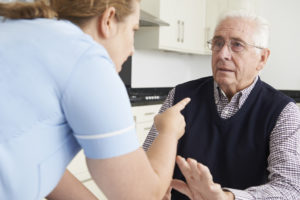Nursing Home Abuse Lawyer
 Nursing home abuse and neglect cases are becoming far too common across the country. One of the most frequent types of neglect nursing home residents are subject to is pressure ulcers, commonly referred to as bedsores. Many residents are bedridden or confined to wheelchairs, which makes them at risk of developing this condition. However, the risk is decreased significantly if nursing home staff take the steps to make sure that the resident is moved and turned on a regular basis throughout the day.
Nursing home abuse and neglect cases are becoming far too common across the country. One of the most frequent types of neglect nursing home residents are subject to is pressure ulcers, commonly referred to as bedsores. Many residents are bedridden or confined to wheelchairs, which makes them at risk of developing this condition. However, the risk is decreased significantly if nursing home staff take the steps to make sure that the resident is moved and turned on a regular basis throughout the day.
A pressure ulcer will develop if the blood supply is frequently cut off from the skin, something that can occur frequently in bedridden residents. When this happens, the skin becomes damaged and can begin to die. Left untreated, the skin will break open as the skin is eaten away, exposing the area and making it vulnerable to potentially fatal infections. The locations of the body where pressure ulcers are more at risk to form include:
- Back of the head
- Back and sides of the knees
- Heels of the feet
- Hips
- Shoulder blades
- Tailbone
There are four stages of pressure ulcers:
- At stage one, the area where the sore is located is usually red and warm. Symptoms can include itching, burning, and pain. Usually, there is no open sore at this stage.
- At stage two, there is often a break in the skin in the area, or a painful sore may develop. The resident is also suffering from significant pain from the ulcer at this point. Often, the skin suffers damage that cannot be repaired.
- At stage three, the ulcer starts to form a crater beneath the surface of the skin. It is often possible to see fat from the open sore.
- At stage four, there is damage being inflicted on tissues, tendons, and joints. The ulcer has eaten through the skin and is very deep. There is so much damage that the resident no longer feels pain, however, there is a high risk of severe infection which is often fatal.
How Are Bedsores Treated?
When a nursing home resident begins to develop bedsores, it is critical for nursing home staff to take the steps to treat the sores in order to prevent them from getting worse. These steps include:
- Make sure the resident is moved on a regular basis in order to ease up the pressure on the area where the sore is developing. This enables the blood to start flowing again.
- Make sure the area around the sore is kept clean and keep the sore covered with medicated gauze
- Ensure the resident is eating a balanced and nutritious diet
- Remove any tissue that has become damaged or infected
- Graft new and healthy skin to the area of the sore
In the majority of cases, the acceleration of stages of pressure ulcers is preventable if the proper steps are taken and the resident is moved frequently by staff. And since the resident is often suffering from pain in the early stage of a bedsore, the nursing home staff cannot claim they were unaware that the bedsore existed. Failure to properly care for the resident is nursing home abuse and a nursing home abuse lawyer should be contacted.
Thanks to each nursing home abuse lawyer from Disparti Law Group for their insight into signs of nursing home abuse and pressure ulcers.
